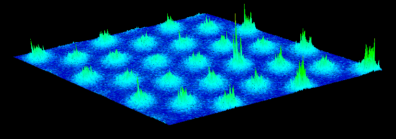Quantum Fluids and Solids
Motivated by the search for exotic phases of matter, we are interested in the study of quantum fluids and solids (QFS). Such are substances in which the interaction between the constituent atoms or molecules is governed by the laws of quantum mechanics. This can give rise to unusual and exotic phenomena. Perhaps the most well known of these this is superfluidity. A more controversial example is the proposition of QFS that exhibit simultaneous types of order — e.g., a spatially-ordered material with superfluid properties (a supersolid). Of particular interest are QFS in reduced dimensions.
The study of QFS has and continues to play a pivotal role in the development of key concepts and ushering paradigm shifts in quantum many-body physics.
More “conventional” condensed matter is described here.
A discussion of the methods that we use, including method development is described here.
QFS in Reduced Dimensions
Evidence of nonclassical rotational inertia (supersolidity) in solid 4He was observed in 2004 (here and here); in 2012, however, the same group found no such evidence (here). Theory and calculations have the potential to provide definitive answers. In 2011, calculations suggested the possibility of supersolidity in 2D (here); calculations in 2012 though suggested that this is only the result of numerical approximations (here).
In order to resolve the above controversies, we are developing computational methods that remove the approximations of prior approaches (see here). As an application of these methods, we are simulating QFS in reduced dimensions; in particular, the phase diagram of 4He on graphene/graphite. An image of a triangular solid of 4He atoms adsorbed on graphene is shown to the left.
